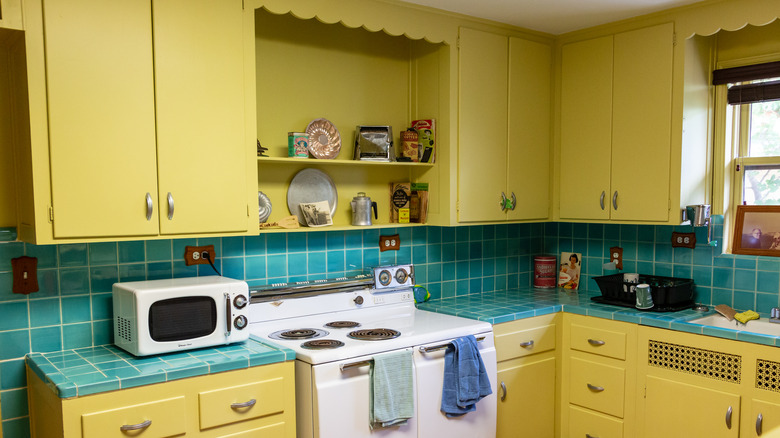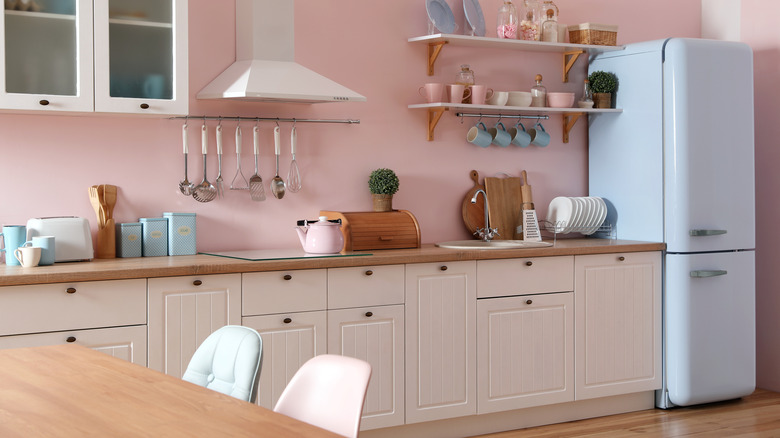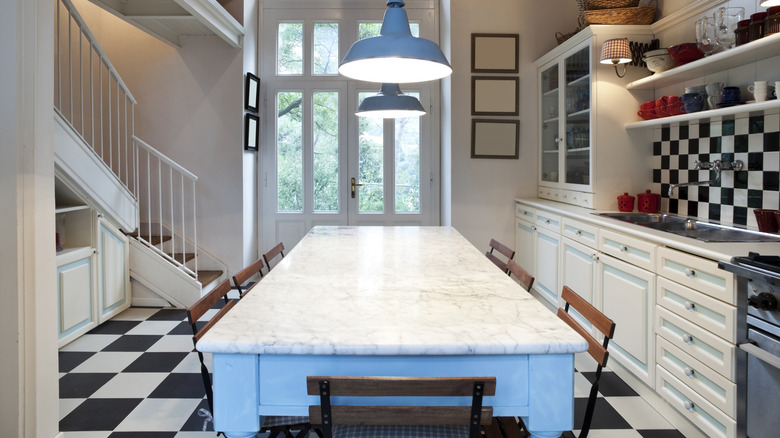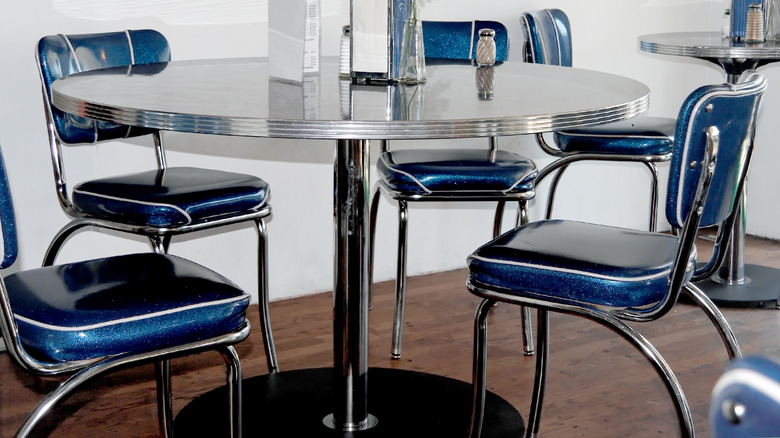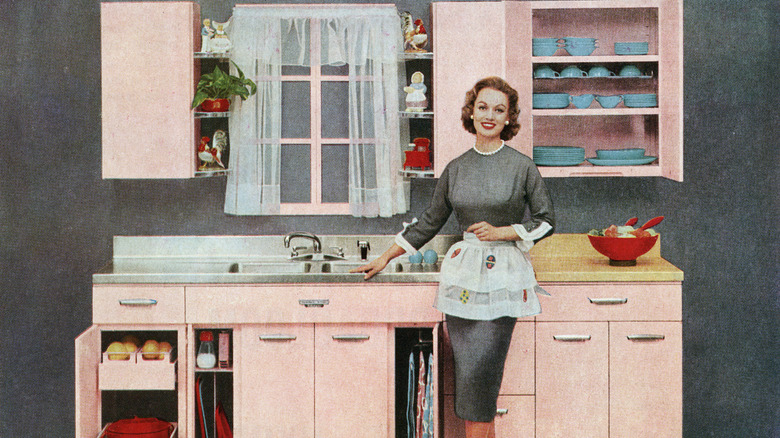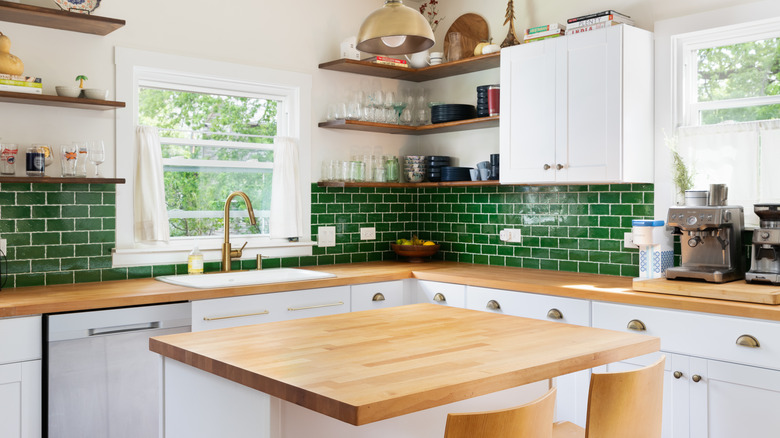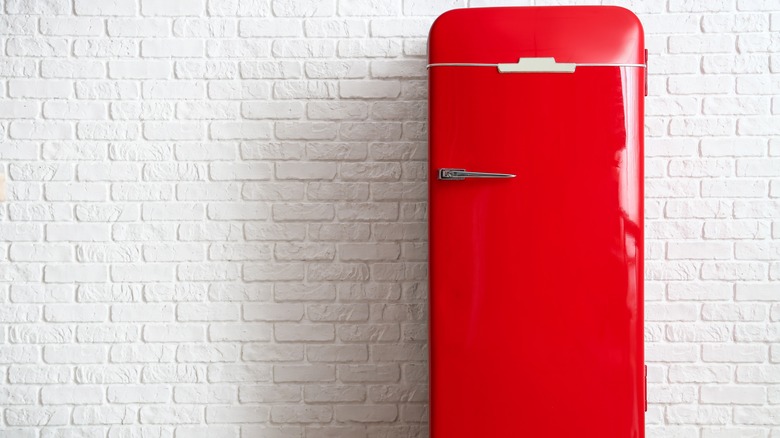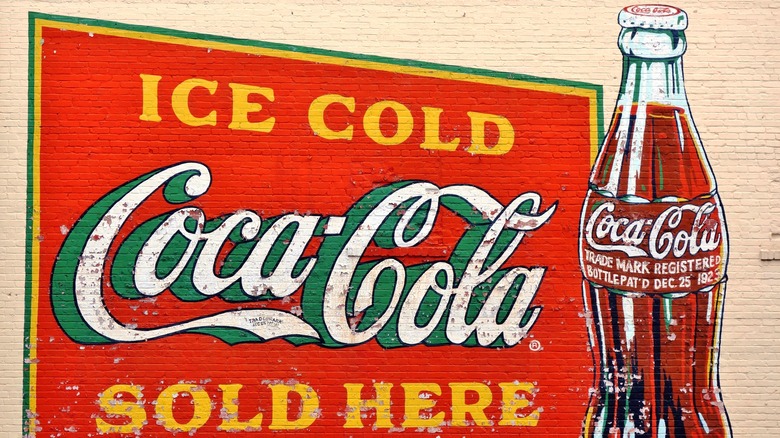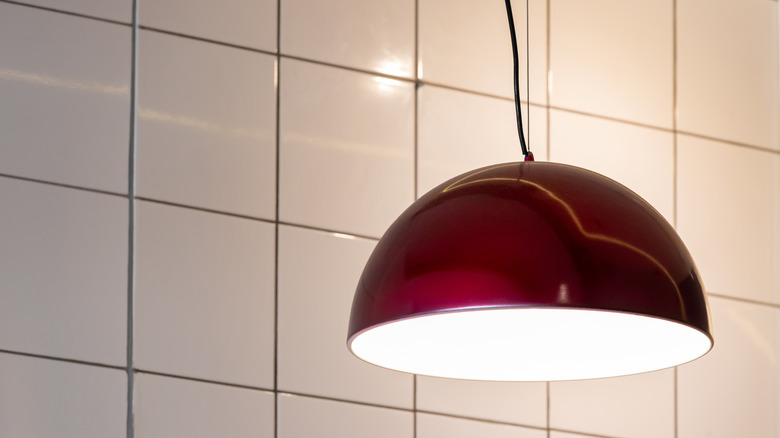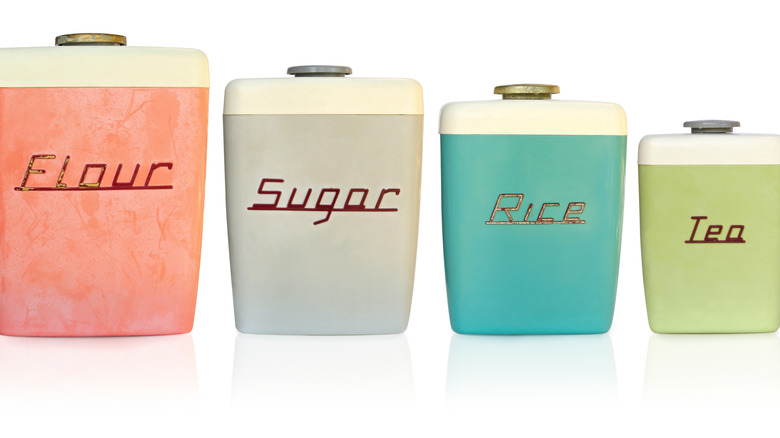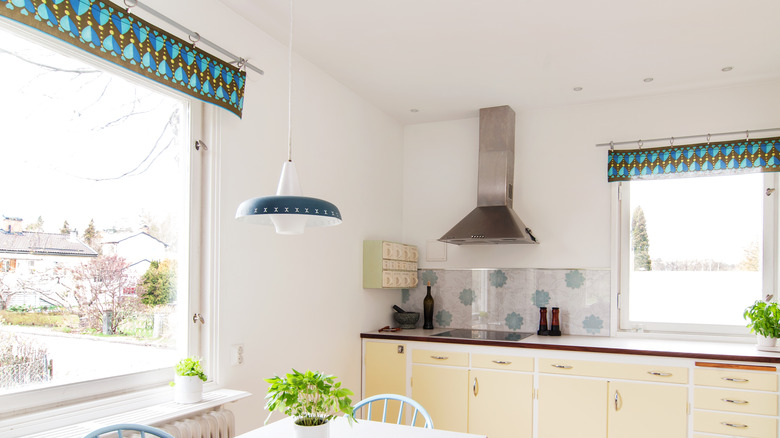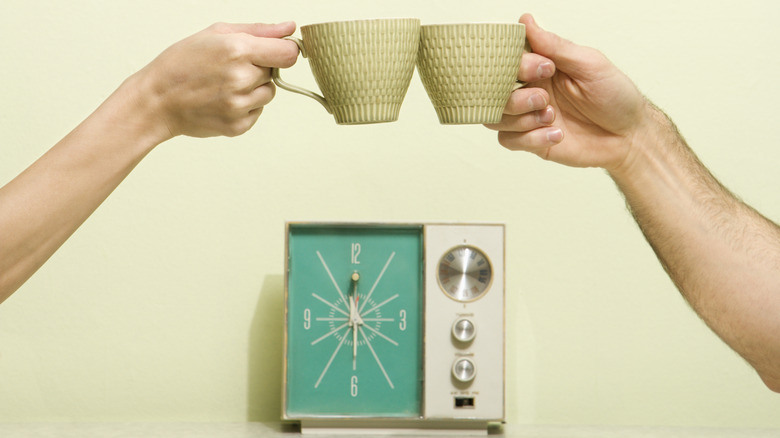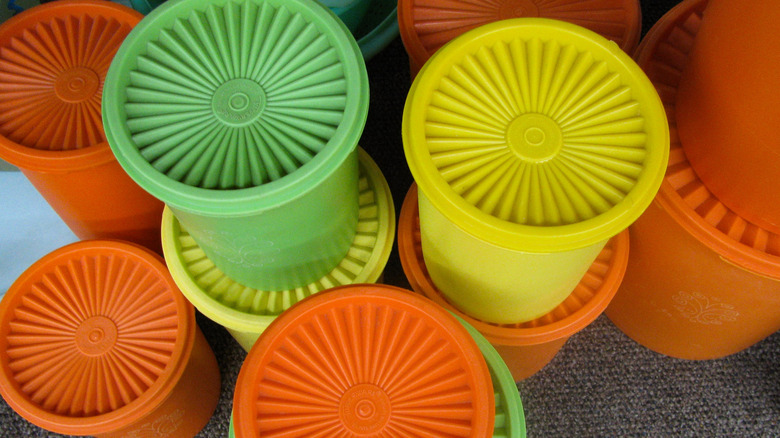How To Create A Retro Style Kitchen
What's the difference between retro, vintage, and antique? According to 99 Designs, a retro item might be produced today. It doesn't have to be physically old. Retro refers to the fact that something is imitating an item from the past. It's a new design that looks old. Vintage or antique describes something that truly is old and was produced long ago. It's physically from the past. According to Fargo Antiques & Repurposed Market, to earn the name vintage, an item has to have been created or produced at least 40 years ago. Antiques are at least 100 years old.
Today, when designing retro kitchens, a popular time period is the late '40s to '50s. Why wouldn't it be? Those decades were full of innovation, beautiful colors and patterns for home interiors, and a time of discovering ways to make the home more efficient. In this article, we'll discuss how to create a retro style kitchen. Add just a splash of retro for an eclectic kitchen, or go all the way by transforming everything from the kitchen light fixtures down to the flooring. Poodle skirts and saddle shoes are not required, but highly recommended.
Fun retro colors
Retro style is all about color, which is one of the many reasons people fall in love with it. For a look that replicates the late '40s or '50s, you can choose just about any of the color schemes. Just don't go boring, because that is anything but retro. Glamorously Vintage points out that retro colors include lovely pastels in pink, blue, yellow, and green. In stark contrast, they also include bold cherry red, often bravely paired with light-colored cabinets and black and white floors. Plenty of peach, turquoise, and teal accents and furniture make a retro kitchen nothing short of dreamy. Photos of kitchens from this time period might remind you of a yummy bowl of sherbet.
To get your retro kitchen design going, you'll need to settle on your favorite colors to use as a palette. Obviously, that won't be easy since all the color choices are delicious. Thankfully, you can mix two or three together. Imagine powder blue walls and pink cabinets, mint green walls with red appliances, or bright white with splashes of teal. Pure heaven.
Retro flooring
When you think of retro flooring, it's impossible to not envision black and white checkered floors. Large squares of black and white flooring are the perfect fit for your retro style kitchen. Other styles can be used as well, especially anything in geometric patterns. The '50s saw pink and black, black and white, green and yellow, red and white, and other kitchen floor color combinations. If it's bright and fun, it's probably retro. Linoleum flooring was all the rage because of its affordability and ease of cleaning, while tile remained a favorite as well.
Today, BuildDirect recommends vinyl flooring for your retro kitchen designs. Vinyl is water-resistant, scratch-resistant, highly durable, and comes in many colors and patterns. The right floor sets the stage for your unique, retro kitchen design. Do you envision something subtle that only hints at the fact that you are in love with all things vintage? Or do you want flooring that screams, "Welcome to my retro kitchen!"? Either one will work just fine.
Diner style furniture
There are a few options when choosing retro style furniture for your kitchen. A popular look to go with is anything diner-style. The classic diner table isn't just oozing nostalgia — it's also super durable. The tabletops were made of Formica, often with an aluminum edge. Chrome framed cushioned seats were covered in vinyl, and always in daring colors. Richardson Seating Corp. tells us that Formica is a composite material, sometimes called high pressure laminate, is heat-resistant, and wipes clean easily. Vinyl, which covered the chairs, also cleans up very well and is stain resistant. Richardson Seating Corp. goes on to tell us that vinyl is actually PVC and restaurants use it because it can handle high traffic (i.e., spills and dirt). It's no wonder homeowners of the '50s loved both Formica and vinyl.
Today, you can buy reproductions of these sets for your retro kitchen. They come in absolutely fabulous colors, such as pink, red, blue, or yellow. If you don't want a Formica table and vinyl chairs, a classic farmhouse table can suit your retro kitchen as well.
Counters, cabinets, and hardware
Counters and cabinets are a focal point in any kitchen. For a retro style, have fun with colors or make them all white with bold hardware, such as red or chrome. Back then, Formica wasn't just for tables — it also graced countertops in kitchens and still does today for those who want that style.
Painting your kitchen cabinets is one of the biggest bangs for your buck when designing a retro style kitchen. Rather than buy all new cabinets, choose the color you want and purchase painting supplies at your favorite home improvement store. Glossy paints work well and are easy to maintain because you can clean them just by wiping. You can paint all cabinets by hand or use a paint sprayer. Make sure to clean and sand cabinets first. Some great color choices are pastel pink, light blue, white, yellow, or mint green.
If you like the shape of your cabinet and drawer hardware but want to change it up a bit, you can paint that as well. The Weathered Door says to remove all hardware, clean it, let it dry, prime with an oil-based primer, and then paint with metallic paint or any color of your choice. For both the primer and the paint, use spray paint. Seal it all with some lacquer spray. And just like that, you've got new cabinets and hardware, along with a retro style, for very little money.
A backsplash that stands out
It's all about tile for your retro backsplash. Colorful or white subway tiles, geometric designs, or penny tiles are the perfect backdrop for a nostalgic kitchen. To save on cost, penny tiles are a great option, especially if you're a DIYer. They come adhered to mesh sheets, and Avalon Flooring says this is what makes installation easier, and the cost reasonable. Carlisle Wide Plank Floors reminds us that another way to keep costs down is to not go all the way up the wall. Doing a partial backsplash will save you money and the backsplash will still be able to perform its job.
For an all-white kitchen, you may want to let the backsplash take center stage in a bright red or yellow, or make everything white and let your retro style appliances or accessories be the star of the show. It's best to decide on the backsplash before you choose appliances. It's easier to get the backsplash installed before the new appliances show up.
Appliances that pop
Have you noticed a colorful theme? The decade following World War II, which we now consider retro, was all about color. Designers wisely chose to bring back some joy and fun to life after the war by using bold patterns and daring colors. Thanks to them, as we recreate those days gone by, we can enjoy little thrills, like a cherry red or bubble gum pink refrigerator. Yes, you read that right — bubble gum pink appliances. Are you swooning yet? Big Chill, a retro style appliance company, encourages homeowners and designers to get their inspiration from retro home decor. They point out that post-war families began to flee cities for a comfy suburban lifestyle, full of relaxation, recreation, and home interiors that were vibrant and fun. The appliances reflected that lifestyle during those years and are now back to filling homes with their vibrancy again.
Retro kitchen appliances from companies like Big Chill come in colors so delectable that choosing just one is the toughest part. Beach blue, cherry red, pink lemonade, buttercup yellow, and jadite green, just to name a few. If you can swing it, add these appliances — such as a dishwasher, stove, or refrigerator — to your kitchen for the cutest one on the block. If retro appliances aren't in the budget, go for all white or stainless-steel appliances. They tend to go with everything in a retro kitchen. You can also choose one colorful appliance and make the rest white or stainless steel to save on cost.
Vintage signs for wall decor
In a retro kitchen, you can't have too many signs — vintage signs, that is. Trademarks like Coca-Cola add an instant retro vibe to any room. There's a reason why we're drawn to these nostalgic pieces of tin with cute sayings. The Architect's Diary shares that for years consumers have been drawn to "old" items because of the unspoken stories and the secrets of the past that things like an old sign can carry. They point out that often people are drawn to the history more than just the item itself.
Whatever the reason, have fun searching for vintage signs or retro reproductions. Even if a sign isn't old, the reproduction takes us back to the sweet time of soda fountains, jukeboxes, and 55 Chevys. Hang signs anywhere in your kitchen. If there's space above your kitchen cabinets, use that wall area. A colorful sign draws the eyes upward and fills in that gap. Use magnetic signs on your refrigerator or decorate a few cabinet doors. Before you know it, your guests will be asking for the blue plate special. Old restaurant signs and drink and food advertisements are perfect for your retro kitchen and cover a lot of your decorating needs.
Funky retro lights
The lighting you choose can either go unnoticed or make a statement. If a vintage look is what you're after, you might as well let the lighting help you out. For a retro style, look for metal and geometric designs and shapes. Pendant lighting works well in the kitchen. According to Lightology, shapes like saucer pendants and atomic designs were wildly popular in the '50s. They seemed to be inspired by atomic bombs and space satellites. Starburst designs were en vogue as well. Since red was fashionable in the kitchen, a red metal pendant light or two would be fabulous above a kitchen island. You can use modern lighting, such as recessed lights, and just add a retro light or two to get your point across. Look for reproductions, if possible, to get a new light fixture that looks like it's straight off the set of "Leave It to Beaver," but operates like it was made in this century.
If you prefer to be a bit more adventurous, you can scour antique shops, flea markets, or online second-hand stores for a truly vintage light fixture. Keep in mind, however, that old lights may need new wiring if that hasn't been taken care of yet. Get your retro fixture checked out by an electrician before installing it.
Flea market finds
If you want to top off your new retro kitchen with the right decor and accents, you've got to hit some flea markets. Flea markets are treasure troves, full of old tins, bread boxes, and other gems from the '40s through '60s.
If you're a newbie to flea markets for decor, take some advice from My One Hundred Year Old Home, which has some helpful hints. They recommend you show up early, bring plenty of cash, and be prepared with something (such as a bag or cart) to hold the items you buy. Carry a bottle of water and your trusty tape measure. Also, they add, measure any areas in your home where you might place something like furniture before you go, so you know what size you're looking for. Alway be friendly when negotiating — politeness goes a long way.
The best way to decide which retro or vintage items to get for your fun kitchen is to see what catches your eye. If you've come this far, you'll likely be able to tell what's from the era you're trying to replicate. Everyone has that one thing that floats their boat. Maybe you'd like to fill a Hoosier hutch or open shelves full of Pyrex dishes, while another person would rather fill those shelves with a collection of '50s clocks and radios. Flea markets are a great way to get your creative juices flowing and top off your retro style kitchen.
Patterned window treatments
Speaking of patterns, have you noticed one? From backsplashes and wall colors, to furniture and window coverings, retro is fun, colorful, and full of unique designs. Go all out with playful kitchen window coverings. According to Budget Blinds, the '50s home covered every window with curtains. They were usually a simple design, but nevertheless, they were everywhere.
Today, in your retro style kitchen don't feel you must have curtains to pull it all together. Many people enjoy the open feeling of uncovered windows. Still, if you can squeeze in even a valance or café curtain in a geometric pattern, or a shade that coordinates well with your pastel-colored or black, white, and red '50s kitchen, then all the better. Use a tension rod, which requires no hardware, on a small window to make things easy, or choose curtain rods that are chrome to go with the retro vibe and possibly match your kitchen hardware.
Set the table with retro dishes
Your retro kitchen isn't complete without a properly set table. Now is your chance to get eclectic with colorful aluminum cups, Pyrex, milk glass, jadeite, and don't forget your Fiestaware. Taste of Home has some fun Fiestaware facts: the original colors were red, cobalt, light green, ivory, turquoise, and yellow. In the '50s, because interior design palettes changed, the Fiestaware colors changed as well, adding shades like rose, gray, forest green, and chartreuse. You could probably get away with any Fiestaware you like, but if you want to be legit, search for the '50s shades.
Another colorful addition in the '50s was aluminum cups. The National Museum of American History says these unique cups came about when manufacturers were producing items meant to be enjoyed outside. Backyards were the thing and grilling was king. The aluminum made them quite durable and the colors made them fun. They're another item you can find when antiquing or just hop online and order reproductions. Whatever you choose, feel free to keep a table set or display your rare retro dishes on open shelves. Even keeping them tucked away and only bringing them out for guests is a great way to start a conversation.
Throw yourself a Tupperware party
If you think Tupperware parties left us a while ago, think again. Not only will Tupperware completely round out your retro kitchen, but it's actually useful. History shares some valuable insights about Tupperware. Early on, it was more than a way to store leftovers and organize the pantry. Tupperware allowed women of the '50s and '60s to have their own businesses. Sadly, that was a rare and new opportunity for women. Enter our hero, Brownie Wise, who, as CBS News tells us, sold so much Tupperware in the '50s that she was the first woman to appear on the cover of Business Week. Way to go, Brownie!
Besides the inspirational business model, as a new kitchen staple, people loved Tupperware because it was, and still is, different than other plastics. It didn't stain or hold bad odors and became infamous for its airtight "burping" lids.
So, what are you waiting for? You can still buy Tupperware today or hunt down the glorious pastel shades of long ago. Use it to organize your pantry so you feel retro at every turn in your kitchen, or display it proudly and let your friends reminisce about visits to grandma's house.
